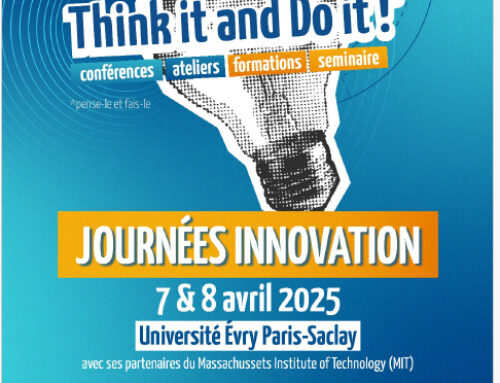TITRE : Étude de la fidélité des interactions haptiques dans un simulateur d’anesthésie locorégionale
Mots clés: Interaction-Homme-Machine, Réalité Virtuelle, Fidélité des interactions, simulation médicale
Contexte
Ce stage s’inscrit dans l’axe de recherche du laboratoire IBISC sur la simulation médicale. Il sera réalisé dans le cadre d’un projet de recherche en partenariat avec le Centre Hospitalier Sud Francilien (CHSF).
Problématique
Les simulateurs basés sur les technologies de la réalité virtuelle permettent d’améliorer de façon significative la formation des professionnels de santé [4, 6]. Ces outils permettent la formation des compétences techniques et psychomotrices nécessaires pour leurs tâches (ex. maniement des instruments, confection des nœuds, dissection de tissus). Cependant, il y a actuellement un manque de lignes directrices pour définir les niveaux appropriés de fidélité d’interaction pour ces systèmes. Dans ce contexte et dans le cadre d’un projet de recherche en collaboration avec le CHSF, nous envisageons d’étudier la fidélité des interactions dans un simulateur d’anesthésie locorégionale. La problématique à traiter dans ce stage concernera l’étude des interactions haptiques dans ce simulateur et l’évaluation de leur impact sur l’expérience utilisateur et sur les performances des apprenants. Pour réaliser ce travail, nous nous appuierons sur nos études préliminaires sur le sujet [1, 2, 3, 4, 5, 7, 9, 10] et sur les simulateurs virtuels que nous avons déjà développés (figure 1) au sein de notre équipe. Ce travail permettra d’apporter davantage de réponses concernant la conception d’outils immersifs pour l’apprentissage des gestes techniques en médecine.
Travail à réaliser
- Réaliser une étude de l’état de l’art du domaine,
- Identifier les contraintes du système et caractériser les interactions haptiques à inclure. Cette tâche sera réalisée en collaboration avec nos partenaires cliniciens à travers les observations dans les blocs opératoires et la discussion avec les experts.
- Améliorer les prototypes existants. Le stagiaire se basera sur les développements déjà réalisés au sein du laboratoire,
- Réaliser au moins une évaluation préliminaire des nouveaux prototypes. Celle-ci consistera par exemple à évaluer les choix des différentes technologies adoptées,
- Publier les résultats dans une conférence nationale ou internationale.
Compétences et qualités requises
Bonne maîtrise de la conception/programmation (si possible Unity/C#), connaissances des interactions 3D, des dispositifs haptiques, et de la méthodologie de conception centrée utilisateur. Des compétences en mécatronique sera un plus. Goût pour la recherche, le travail d’équipe et les échanges pluridisciplinaires.
Conditions du stage
- Le stage se déroulera au laboratoire IBISC (équipe IRA²). Une plateforme expérimentale (plateforme EVR@) et des EV pour la simulation chirurgicale sont mis à disposition. Le stagiaire sera en interaction avec des doctorants et d’autres stagiaires de l’équipe. Il sera également convié à participer à certaines réunions avec les partenaires du projet et à faire des observations sur le terrain au CHSF.
- Durée : 6 mois (entre février et octobre 2024, selon disponibilités)
- Gratification minimale légale (~550€/mois)
Lieu du stage
Laboratoire : IBISC (Équipe IRA²)
Localisation : 36, rue du Pelvoux, 91000 ÉVRY-COURCOURONNES
Title: Study of Haptic Interaction Fidelity in a Virtual Reality Regional Anesthesia Simulator
Keywords: Human-Computer Interaction, Virtual Reality, haptic fidelity, medical simulation
Context
This internship is part of the research axis of the IBISC laboratory on surgical simulation. It will be carried out as part of a research project in collaboration with the Centre Hospitalier Sud Francilien (CHSF).
Research problematic
Virtual reality-based simulators can significantly improve medical training [4, 6]. These tools allow the training of the necessary technical and psychomotor skills to perform surgical tasks (e.g., instrument handling, knotting, and tissue dissection). However, there is currently a lack of guidelines for defining the appropriate levels of interaction fidelity for these systems. In this context and as part of a research project in collaboration with the CHSF, we plan to study the fidelity of interactions in a regional anesthesia simulator. The research problematic to be addressed in this internship will concern the study of haptic interaction fidelity in these simulators and to evaluate its impact on the user experience and the learners’ performance. To carry out this work, we will rely on our preliminary studies on the subject [1, 2, 3, 4, 5, 7, 9, 10] and on the virtual simulator that we have already developed (figure 1) within our team. This work will provide more answers regarding the design of immersive tools for learning technical skills in medicine.
Work description
- Conducting a literature review of the research field,
- Identifying the system constraints and characterizing the haptic interactions to be included. This task will be carried out with our clinical partners through observations in the operating theaters and discussions with experts.
- Improving the existing simulation prototypes by designing new haptic interactions,
- Carrying out user studies to evaluate the prototypes. This will consist of assessing the technology design choices,
- Publishing the results in a national or an international conference.
Qualifications
Good experience in design and programming (Unity 3D/C#), knowledge of 3D interactions, haptic interfaces, and user-centered design. Skills in mechatronics will be appreciated. High interest in research, teamwork, and multidisciplinary work.
Work conditions
The work will be done within the IRA² team at the IBISC Lab. An experimental platform (EVR@) and existing virtual environments for surgical simulation will be available. The trainee will constantly interact with the team’s PhD students, postdocs, and other trainees. He/she will also be invited to participate in research meetings with the project partners and to conduct field studies.
Duration: 6 months (from Feb to Oct 2024, depending on the trainee’s availability)
Compensation: minimum legal compensation (~550€/month)
Contact
- Merci de faire parvenir une lettre de motivation, un CV et les relevés de notes du Master 1 ou 2 :
- Please send your application letter, a CV and Master transcripts (M1/M2) to:
| Amine CHELLALI | Laboratoire IBISC EA 4526
Equipe IRA2 Bâtiment Pelvoux 2, IUP 40, Rue du Pelvoux CE1455 Courcouronnes 91020 EVRY |
References
[1] Wang, J., Chellali, A., Cao, C.G.L. (2015) Haptic Communication in Collaborative Virtual Environments. Human Factors, 58(3), 496-508, Sage Journals
[2] Mentis, H.M., Chellali, A., Cao, C.G.L., Schwaitzberg, S.D. (2015) A Systematic Review of the Effect of Distraction on Surgeon Performance: Directions for Operating Room Policy and Surgical Training. Surgical Endoscopy, 30 (5), pp. 1713-1724, Springer
[3] Benyahia, S., Nguyen D.V., Chellali, A., Otmane, S. (2015) Designing the User Interface of a Virtual Needle Insertion Trainer. In the proceedings of the International Conference of the Association Francophone d’Interaction Homme-Machine, IHM 2015, Toulouse, France
[4] Chellali, A. Mentis, H. Miller, A., Ahn, W., Arikatla, V.S. et al. (2016) Achieving Interface and Environment Fidelity in the Virtual Basic Laparoscopic Surgical Trainer. International Journal of Human-Computer Studies, 96, pp.22-37, Elsevier
[5] Ricca, A., Chellali, A., & Otmane, S. (2021). Comparing touch-based and head-tracking navigation techniques in a virtual reality biopsy simulator. Virtual Reality, 25, 191-208.
[6] Yiannakopoulou, N. Nikiteas, D. Perrea and C. Tsigris, (2015) Virtual reality simulators and training in laparoscopic surgery, International Journal of Surgery, 13: 60-64
[7] Simon, C., Herfort, L., & Chellali, A. (2022). Design and evaluation of an immersive ultrasound-guided locoregional anesthesia simulator. In 2022 IEEE Conference on Virtual Reality and 3D User Interfaces Abstracts and Workshops (VRW) (pp. 445-449).
[8] Ricca, A. Chellali, A., Otmane, S. (2021) The influence of hand visualization in tool-based motor-skills training, a longitudinal study. In the proceedings of IEEE Virtual Reality and 3D User Interfaces 2021 Conference (IEEE VR), pp. 103-112
[9] Herfort, L., Brocas, E., Amelon, F-X., Ricca, A., Chellali, A. (2022). Validation de l’aspect et du contenu d’un simulateur immersif pour la formation des opérateurs en anesthésie locorégionale échoguidée. In IHM ’22: Proceedings of the 33rd Conference on l’Interaction Humain-Machine (IHM ’22). Association for Computing Machinery, New York, NY, USA, Article 8, 1–15. https://doi.org/10.1145/3500866.3516376
[10] Simon, C., Brocas, E., Otmane, S., & Chellali, A. (2023). Analyse de la tâche pour la conception d’un simulateur virtuel pour l’anesthésie locorégionale échoguidée. In 12ème colloque EPIQUE, 233-241.
- Date de l’appel : 21/12/2023
- Statut de l’appel : Non pourvu
- Contact : Amine CHELLALI (MCF Univ. Évry, IBISC équipe IRA2), amineDOTchellaliATuniv-evryDOTfr
- Sujet de stage niveau Master 2 (format PDF)
- Web équipe IRA2


![Figure 1 : UltRASim : notre simulateur virtuel pour l’anesthésie locorégionale (voir référence [9]) Figure 1 : UltRASim : notre simulateur virtuel pour l’anesthésie locorégionale (voir référence [9])](https://www.ibisc.univ-evry.fr/wp-content/uploads/2023/12/Sujet_stage_M2_2024_AC_Etude_de_la_fidelite_des_interactions_haptiques_dans_un_simulateur_d_anesthesie_locorégionale_fig1-21122023-640x480.jpg)




